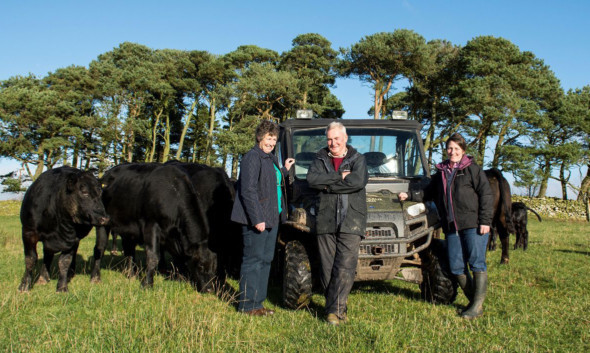A Berwickshire farm with a long-established excellent reputation for producing top-class Aberdeen-Angus cattle has been named 2014 Scotch Beef Farm of the Year.
John and Marion Tilson and daughter Wanda Hobbs were thrilled when their farm, Wedderlie, lifted the award, which is run by Quality Meat Scotland (QMS) and Agriscot.
“We did not think we had much chance as a pedigree herd up against the commercial producers, so it came as quite a surprise when we won,” said Marion Tilson.
However, it was the commercial focus of the farm and the family’s commitment to producing the best cattle which particularly impressed award assessors Jim McLaren and John Elliot.
Wedderlie runs to 2,500 acres, including 900 acres of hill rising to 1,200ft above sea level, and there have been Angus cattle there since the First World War.
Mrs Tilson’s grandfather bought the farm in 1942 and since then it has been passed down the female line through her mother Jenny Campbell, to herself and husband John and now Wanda.
The family are dedicated to producing top-quality livestock, and their attention to detail in both the cattle and sheep enterprises is key to their success.
The 200 pedigree Angus cows are split into spring and autumn calving due to accommodation limitations. The progeny not retained for breeding is either finished, sold for breeding or sold as suckled calves.
Around 60% of the bull calves are kept entire, either for use in their own herd or for sale as breeding bulls.
Mrs Tilson said: “We sell very few bulls at sales now as we have a good customer base who like to buy direct from the farm.”
For the last three years, in January, they have produced a catalogue of bulls for sale, which helps prospective buyers choose their perfect animal. Mrs Tilson believes this has been a great success.
She also credits Wanda with the best marketing and negotiating skills in the family.
Although few bulls go to the Stirling sales, the family believe it is important to keep the name to the fore, which they did very successfully in February when Wedderlie Ebsolution, by stock bull Nightingale El Paso, was reserve champion and sold for 17,000gns.
The remaining bull calves are castrated and those born in the autumn sold store at St Boswells in September. Last year they averaged just over 476kg and £1,238.
Spring calves have a second summer at grass and are finished at 16 to 18 months with some supplementary feeding. They go to Scotbeef, where this year they averaged 362kg and graded U or R4L.
The best of the heifer calves are retained in the herd and, following a winter away at another farm to free up housing at home, they calve down at two-years-old.
Mr Tilson said: “Calving at two years is important. It means females are likely to be good milkers for the rest of their breeding life, and it is more efficient.
“It has been calculated that a heifer calving at two years and her female descendants will, between them, produce a total of 42 calves by the time she is 10, compared to only 19 if she has her first calf at three years.”
There is also a strong demand for the surplus heifers for breeding, while the bottom third are sold as suckled calves at St Boswells.
Mrs Tilson added: “We believe it is the commercial side of the business which gives us an advantage in the pedigree sales. We focus heavily on correctness of conformation and carcase, and that influences our breeding programme.”
The herd is closed and part of SAC’s Premium Cattle Health Scheme, so new bloodlines are introduced through an embryo transplant programme.
The Tilsons have leased a cow in Canada which has been flushed, and her sons have been used heavily in the herd.
“We have flushed her with older American genetics with big frames.
“It would be easy to let the breed get too small again but we would lose our commercial customers, who are looking for big, easily fleshed bulls to do a job on cross cows,” Mrs Tilson added.
They are also advocates of line breeding from proven bloodlines, and some of the existing cows go back to the original foundation females over 100 years ago.
The Tilsons are both past presidents of the Aberdeen-Angus Cattle Society and Mrs Tilson, as chairman of the society’s technical committee, was instrumental in persuading it to adopt the Australian Breedplan performance recording system.
The Tilsons use Estimated Breeding Values (EBVs) mostly for the traits they cannot see, such as depth of eye muscle and milk.
They rely heavily on their expertise as stock people to identify the right animals for replacements and breeding based on correctness and locomotion, combined with femininity for the cows.
The Tilsons have made some brave breeding decisions regarding the Angus herd, largely ignoring fashion and popularity, and choosing to take their own route, and this has paid off over the years.
They are currently making the same decisions regarding the 1,760 ewes on the farm.
The Blackface ewes which run on the hill are being phased out with the introduction of Cheviots, which are crossed with the Bluefaced Leicester to give a Cheviot mule flock on the lower ground and then Texels are used as a terminal sire.
All the lambs are finished, plus a further 250 bought-in Cheviots, and sold to Scotbeef where they typically average 19kg with Texels usually U grade and Cheviots R.
“We find the Cheviot carcase grades better, the cast ewes are worth more and it is easier to source good tups,” Mrs Tilson said.
